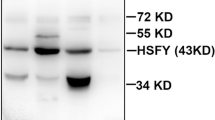Abstract.
In addition to appearing in response to biological stresses, heat shock proteins are expressed as 'chaperones' by some cells living in physiological conditions. Among these proteins, the HSP90 family seems to function under normal growth conditions in the pathways of numerous signal transducers, cell-cycle and developmental regulators. The aim of this study was to investigate the immunohistochemical expression and the distribution of the two mammalian cytosolic isoforms of HSP90 (HSP84 and HSP86) during mouse development between E6 and E16. Our immunohistochemical investigations revealed a diffuse and ubiquitous expression of HSP84 distributed throughout the embryo in all stages. On the other hand, HSP86 was specifically noticed in diverse somatic cells such as hepatoblasts and epithelia that could traduce cellular differentiation phenomenon. More interestingly, a strong cytoplasm expression of HSP86 could be demonstrated in primordial germ cells from their appearance on the yolk sac membrane until reaching the genital crest. These results suggested a protective mechanism against the phenotypic expression of mutations induced by environmental changes in vertebrates as has been demonstrated in Drosophila.
Similar content being viewed by others
Author information
Authors and Affiliations
Additional information
Electronic Publication
Rights and permissions
About this article
Cite this article
Vanmuylder, N., Werry-Huet, A., Rooze, M. et al. Heat shock protein HSP86 expression during mouse embryo development, especially in the germ-line. Anat Embryol 205, 301–306 (2002). https://doi.org/10.1007/s00429-002-0258-5
Accepted:
Issue Date:
DOI: https://doi.org/10.1007/s00429-002-0258-5




